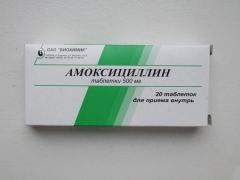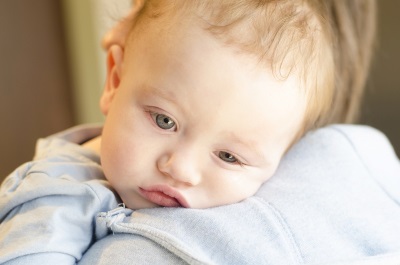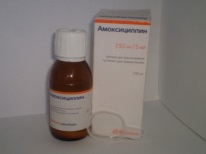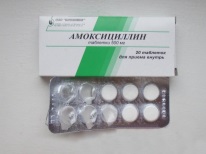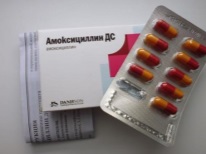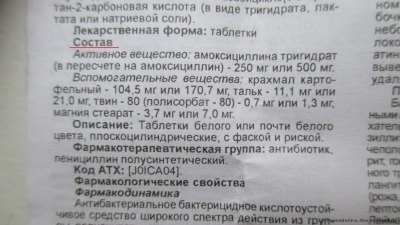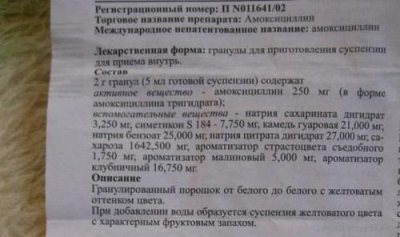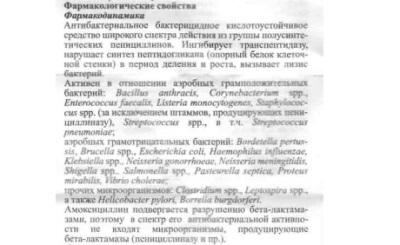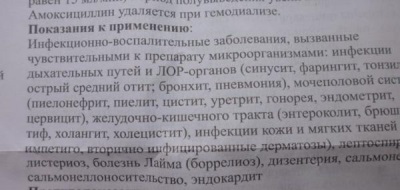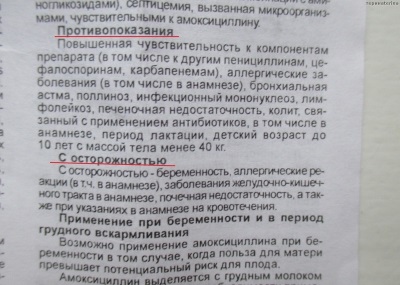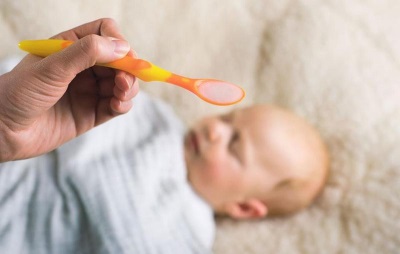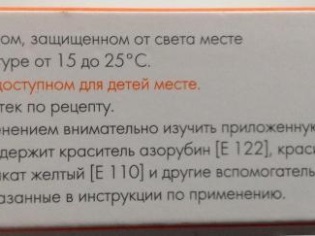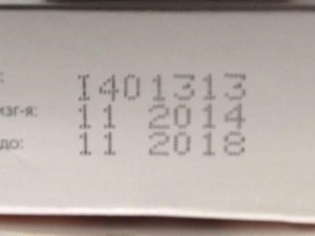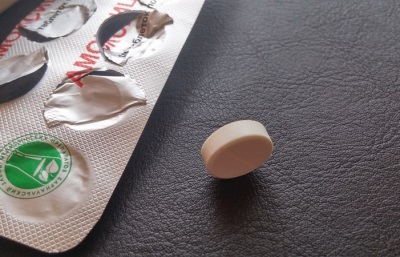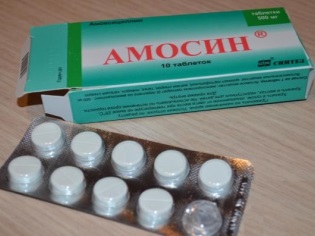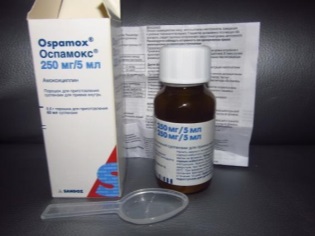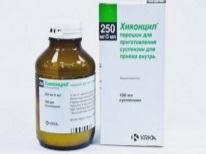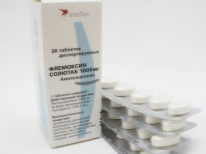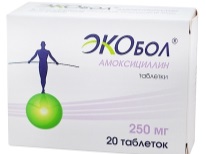Amoxicillin for children
Penicillin antibiotics are widely used in the treatment of bacterial infections in childhood. One of the most popular can be called Amoxicillin. Pediatricians often prescribe it to children, but many mothers doubt whether it is worth using it and whether it is possible to give this medicine at the age of one year, for example, to a month-old baby. Also, parents are often interested in how to dilute such a medicine and in what dose it can be given to children.
Release form
There are such forms of Amoxicillin:
- Granules. They are sold in glass dark bottles weighing 40 g. Each such bottle contains white-yellow or white powder in such quantity that after adding water it turns out suspension in a volume of 100 ml. Such a yellowish sweet fruit mixture is easily dispensed using the measuring spoon in the package. A full spoon contains 5 ml of liquid medicine, from which a sick child receives 250 mg of the active ingredient. Inside the spoon you can also notice the risk of having collected a suspension to which you get a half dose of 2.5 ml of the drug / 125 mg of the active ingredient.
- Pills, presented as usual tablets, and in a film cover. They are available with an active ingredient content of both 250 and 500 mg, and one pack of tablets may contain 10, 20 or more.
- Capsules This form of Amoxicillin is represented by white-green gelatin capsules. Inside each of them is a yellowish or white powder containing 250 or 500 mg of the active compound. In one box can be 16, 10, 20 or more capsules.
As you can see, Amoxicillin is available only in the form of drugs that are taken orally. Injections with such an antibiotic are not performed.
Composition
The main substance Amoxicillin, due to which the drug has an antimicrobial effect, is represented by amoxicillin trihydrate.
This compound is complemented by other ingredients that differ in different forms:
- Pills additionally contain potato starch and magnesium stearate, and if they are coated, they may additionally include titanium dioxide, talc, hypromellose and other components.
- In granules In addition to the active component, there are flavors (they give the drug a strawberry-raspberry smell) and sweeteners (saccharin and sucrose). In addition, this form includes guar gum, Na citrate, simethicone and Na benzoate.
- Inside the capsules In addition to amoxicillin, there is microcrystalline cellulose and magnesium stearate, and gelatin and several types of dyes are used to make the body of capsules.
Operating principle
Amoxicillin is one of the antibiotics included in the "penicillins" group. It has a very wide range of antimicrobial effects. The drug acts on the walls of bacterial cells, as a result of which they are damaged and microbes die. This effect is called bactericidal.
It is celebrated in relation to:
- Streptococcus
- Gonokokkov.
- Staphylococcus.
- Peptostreptokokk.
- Pneumococci.
- Intestinal sticks.
- Shigella.
- Salmonella
- Klebsielle.
- Meningococci.
- Enterococci.
- Borrelia
- Clostridium.
- Corynebacteria.
- Chlamydia.
- Listeria.
- Protea.
- Treponem.
- Campylobacter.
- Helicobacter.
- Fuzobakteriy.
Once in the patient's digestive tract, amoxicillin trihydrate is not destroyed by the acidic environment of the stomach, but rather rapidly absorbed in the intestine. The maximum concentration of this compound in the blood is determined within one or two hours after administration.
Further, the drug penetrates quite well into the mucous membranes, fluids, bronchial secretions, urine and other tissues of the body. Amoxicillin excretion occurs predominantly by the kidneys. The drug is completely excreted in the urine within 6-8 hours.
It should also be noted that in the body part of Amoxicillin destroys an enzyme called penicillinase. In addition, not all microbes die under its influence. There are insensitive to Amoxicillin types of staphylococci and streptococci.
The drug is often ineffective when infected with pseudomonads, serration, bacteroids, Proteus or enterobacter. In addition, Amoxicillin does not help get rid of rickettsia or mycoplasma. It does not have any effect on viruses, so its use in case of SARS, influenza, viral stomatitis and colds is not justified.
Indications
Amoxicillin for children is effective in such diseases:
- In case of sore throat, otitis and bacteria damage other ENT organs.
- With pneumonia, tracheobronchitis, pharyngitis, bronchitis and any other infections of the respiratory system.
- In case of cystitis, nephritis, urethritis and other microbial lesions of the urogenital system.
- For some intestinal infections, such as salmonellosis or dysentery.
- With leptospirosis, borreliosis, gonorrhea and listeriosis.
- With scarlet fever and other streptococcal infections.
- With meningitis.
- With sepsis.
- With peritonitis or cholangitis.
- In peptic ulcer disease, if its cause is the Helicobacter bacterium.
At what age is it allowed to take?
Treatment of children with Amoxicillin is allowed from birth, but babies younger than 2 years old are prescribed medication only by a doctor and only in cases when there is a reason for it. Until 5 years of age, the drug is discharged in granules, since it is more convenient for small children to give medicines in a liquid form. Children older than 5-6 years can be given as a suspension, and tablets. If a child swallows solid medicines well, from the age of 5 Amoxicillin can be offered in capsules.
Contraindications
Amoxicillin should not be administered to a child if he is allergic to this or any other antibacterial drug of the penicillin group. An allergic reaction to cephalosporin drugs will also be a contraindication.
Limitations under which this antibiotic is refused or taken with the use of Amoxicillin with caution also include:
- Pathology of the kidneys.
- Lymphocytic leukemia.
- Liver disease.
- Pollinosis, bronchial asthma and other allergic diseases.
- Breast-feeding.
- Dysbacteriosis.
- Bleeding in the past.
Side effects
Among the possible negative symptoms with which the child’s body responds to treatment with Amoxicillin, there are:
- Allergic reactions, for example, urticaria, runny nose or conjunctivitis. Very rarely, taking Amoxicillin can lead to anaphylaxis and other serious allergies.
- Disorders of the digestive tract. The use of medication often causes nausea or thinning of the stool. Amoxicillin also noted a negative impact on the liver, the ability to cause dysbiosis or enterocolitis.
- Negative changes in the nervous system. They are manifested by dizziness, anxiety, bad mood, headache, insomnia, agitated condition and other symptoms. In extremely rare cases, the drug can trigger seizures.
Also taking Amoxicillin can affect the blood test (the number of formed elements decreases), pulse rate and respiration. In addition, treatment with such medication, although rare, leads to superinfection and candidiasis.
Instructions for use
Any form of Amoxicillin is taken orally, and since food does not affect the absorption of this drug from the gastrointestinal tract, it is possible to drink such an antibiotic both after meals and before meals. The drug is taken three times.
Dilute the granules with water, which is pre-boiled and cooled to room temperature. The bottle with the powder is filled with liquid, then it is closed and with the help of agitation to achieve uniform mixing of the dry matter with water. To measure for the child the right amount of suspension, use a spoon, which is sold with a bottle.
Amoxicillin tablets or capsules offer the child to swallow and drink water. The duration of treatment in different diseases will be different and can be up to 12 days. To determine it, the main criterion of doctors is the disappearance of clinical symptoms - from this point on, the drug is given for another 2-3 days.
Dosage
- For babies of the first two years of life, a single dose of Amoxicillin is selected by weight. To calculate it, you need to multiply the body mass of the crumbs in kilograms by 20. The resulting figure will be the amount of mg of amoxicillin per administration. For example, a child in 1 year weighs 10 kilograms, we make a calculation of 10x20 and we get 200 mg of active substance.
- Children over 2 years of age require 125 mg of amoxicillin at a time. In the indicated single dose, the medicine is given up to 5 years of age. It corresponds to 2.5 ml of the drug in suspension.
- If the child is already 5 years old, the dosage of Amoxicillin at a time is increased to 250 mg, and the medicine can be given in suspension (5 ml), and in tablets (1 tablet containing 250 mg of antibiotic), and capsules (1 a capsule containing 250 mg of active compound).
- A ten-year-old child and older Amoxicillin is given in a single dose of 500 mg. The child can receive so much active ingredient from 10 ml of suspension, as well as from two tablets or two capsules containing amoxicillin trihydrate in the amount of 250 mg. However, it is much more convenient to give at one dose only 1 capsule or 1 tablet, which contains 500 mg of amoxicillin.
In some diseases, the dosage and frequency of use of Amoxicillin change depending on the pathogen, for example, in the fight against leptospirosis or typhoid fever the dose of the drug will be much longer, and the duration of treatment of streptococcal infections should be at least 10 days.
Overdose
Excess doses of Amoxicillin usually leads to diarrhea and bouts of vomiting, and, as a consequence, provokes dehydration. If an overdose is found immediately, gastric lavage is indicated, as well as the use of sorbents. Next, you need to focus on soldering with rehydration solutions to restore the balance of electrolytes and fluids in the children's body. For very severe poisoning, you need to call an ambulance.
Interaction with other drugs
- The use of antacid agents affects the absorption of Amoxicillin in the intestine. The same effect is observed in laxative drugs and glucosamine.
- Amoxicillin should not be combined with antibacterial drugs, which have a bacteriostatic action, for example, with macrolide antibiotics or preparations of the linkosamide group.
- The use of vitamin C improves the absorption of Amoxicillin.
- Other bactericidal drugs “work” together with Amoxicillin synergistically. Such an interaction has been noted in cephalosporins, vancomycin, rifampicin and some other drugs.
- Due to the suppression of intestinal microflora, reduction of the prothrombin index and inhibition of the synthesis of vitamin K, the use of Amoxicillin will enhance the therapeutic effect of indirect anticoagulants.
- Co-administration of amoxicillin and Metronidazole has a negative effect on liver function. Treatment with such a combination of medicines in children is contraindicated.
- In the treatment of diuretics, allopurinol, nonsteroidal anti-inflammatory drugs and some other drugs Amoxicillin will be determined in the blood in higher concentrations.
Terms of sale
To buy in the pharmacy any of the forms of Amoxicillin, you must show a prescription from a doctor. For a bottle of granules you need to pay about 90-100 rubles, and for a package of 20 tablets with 250 mg of active substance - about 30-40 rubles. The average price of a pack of 16 capsules containing amoxicillin at a dose of 250 mg is 60 rubles.
Storage conditions and shelf life
To preserve the effectiveness of the drug should be kept away from direct sunlight and moisture. The optimal temperature for its storage is the range from + 15 ° С to + 25 ° С. Children should not have free access to Amoxicillin.
Unopened packaging with granules has a shelf life of 3 years, but after dilution the drug can be stored for no longer than two weeks. The shelf life of the capsules is 3 years, and the tablets, depending on the manufacturer, are 2-4 years.
Reviews
Parents' impressions of using Amoxicillin in treating their children are quite different. Many were satisfied with the drug, because it quickly helped with temperature and coughing or with another infection. Especially a lot of positive reviews about the suspension, because it is easy to dispense, the taste of the medicine is pleasant, and the cost is small.
However, there are negative comments about Amoxicillin, because in some children the drug causes allergies or digestive problems. Many mothers do not like taking this medicine three times, as well as limiting the shelf life of the finished suspension. There are also cases of Amoxicillin ineffectiveness when it was necessary to replace it with another antibiotic.
Analogs
An analogue with the same active compound can become a full-fledged replacement of the drug, for example
- Amosin. Such a preparation is produced in a powder for the preparation of a liquid medication (suspension) and in tablets. It is also available in capsules.
- Flemoxine Solutab. This medicine is a soluble tablet.
- Ospamox. Such a preparation is produced in powder and granular form (a suspension is prepared from them), as well as in capsules and several versions of tablets.
- Hikontsil. This tool is represented by capsules as well as tablets.
- Ecobol. This antibiotic is produced in pill form.
In addition, the child can be treated with any other penicillin antibiotic (Oxacacillin, Ampicillin), and antibacterial medicine from another group. A combination of amoxicillin with clavulanic acid is considered a very effective substitute. Such components are contained in antibiotics Augmentin, Amoxiclav, Panklav, Flemoklav Solyutab, Ecoclav and others.
Due to the ability of clavulanic acid to prevent the destruction of amoxicillin under the action of penicillinase, such drugs are more effective. And if you evaluate what is better - Amoxicillin or Amoxiclav, then you can answer that clavulanic acid drugs are stronger than drugs containing only amoxicillin.
In the next video, the popular pediatric physician Komarovsky tells why antibiotics are needed and when they are consumed.
